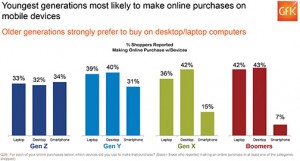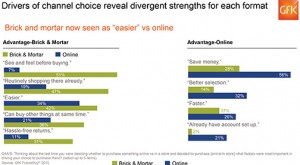
New York, NY—Generations Y and Z part company on key shopping attitudes and habits, from the use of computers for online purchases to the primary reasons for buying in brick-and-mortar stores, according to a new GfK study.
The research firm found some of the biggest gaps between the younger generations and the baby boomers (ages 51–68), who have been slower to adopt mobile shopping habits. Generations Y (25–34) and Z (18–24), often referred to collectively as millennials, are much more likely to make a purchase via a smartphone. According to the survey (see Figure 1), 31% and 34% of gens Y and Z, respectively, reported mobile purchases compared to only 7% of boomers and just 15% of gen X (35–50).

Source: GfK FutureBuy® 2015
Additionally, for purchases made from a desktop or laptop computer, gen Y and the baby boomers registered similar levels (40% and 43%, respectively), while Gen Z came in at just 32%.
In-Store Purchasing Attitudes
The study also shows that gens Y and Z differ in their reasons for choosing to buy in-store versus online (see Figure 2). Notes GfK, when gen Z consumers choose to make online purchases, they are more likely to be motivated by:
• “saving money (better pricing)” (Z: 60%; Y: 46%)
• “recommended by people I trust” (Z: 31%; Y:16%)
Gen Yers who buy online are more likely to cite:
• “get better information” online (Y: 35%; Z: 22%)
• “better delivery options” (Y: 26%; Z: 19%)
• “can buy other things at the same time” (Y: 23%; Z: 17%)

Source: GfK FutureBuy® 2015
In addition, gen Z respondents said they buy in-store because they “get better information” in retail outlets (25% versus 18%). Gen Y, however, cited in-store shopping as being “easier” (42% versus 29%).
“We are used to seeing younger shoppers lumped together in contrast with their baby boomer parents,” said Joe Beier, executive vice president of GfK’s Shopper and Retail Strategy team. “But there are some important differences between the two ‘halves’ of the millennial cohort; in certain areas, we see gen Y tending toward the ‘old-school’ ways of the boomers, but in others, they seem equal to their younger brothers and sisters in gen Z.”
GfK’s FutureBuy findings are based on interviews with 25,000 shoppers globally, including 1,000 in the U.S. gfk.com





